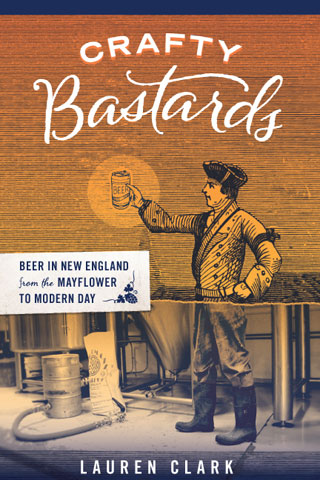Posts Tagged ‘Kentucky’
July 3rd, 2010
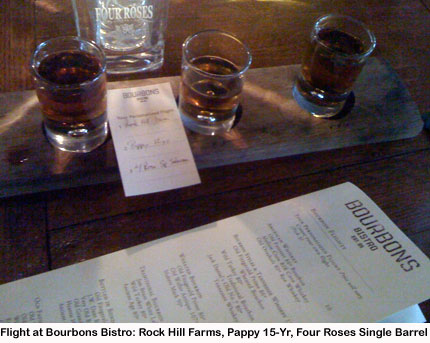
The Kentucky bourbon trail is were you learn all about how bourbon is made. But to really drink the stuff, head to Louisville — that’s where the bourbon bars are. Here are some brief reviews of those “urban bourbon trail” bars, as well as a couple spots in Midway and Frankfort that are well worth a visit.
Bourbons Bistro. It’s “bourbons,” plural. Boy, is it ever. You sit at the bar and contemplate a wall of 130+ different bottles. You peruse the lengthy menu, including several of the flights it helpfully suggests. Then you consult your knowledgeable but laid-back bartender, who tailors a flight to your exact desires. You kick back, sip the tawny goodness, and eavesdrop on what everyone else is ordering. You wish you could come back every night for at least a week to sample even half of the bourbons here, soak it up with high-class southern tavern food, and decompress to the tune of Kentucky accents.
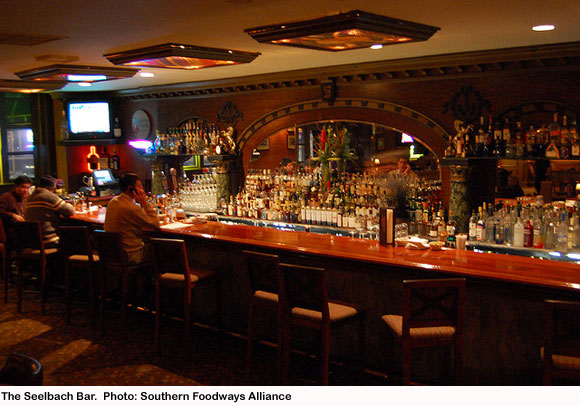
The Old Seelbach Bar. A fixture on numerous “best bars” lists, this landmark hotel watering hole has over 40 bourbons on the back bar. The Seelbach is a grand, early-1900s-era hotel whose plush rooms seem like a real value compared to similar accommodations in bigger cities like New York and San Francisco. I splurged on a room there and happily nursed my bourbon hangover with a giant plate of biscuits and sausage gravy in bed. The one bummer about the Seelbach Bar: like Locke-Ober and its sub-par Ward Eight cocktail, this establishment serves the worst example I’ve ever encountered of its signature Seelbach cocktail — too much liqueur, semi-flat sparkling wine, and only a wan expression of bourbon and bitters.
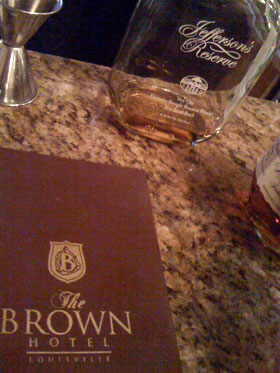 The Brown Hotel Bar. This is in the opulent, marble-enclosed lobby of Louisville’s other grand, old hotel, built in 1923. The comparatively tiny bar nonetheless carries a wide selection of bourbons. I sipped on a Jefferson’s Reserve (a very small-batch whiskey launched by writer and bourbon historian Chet Zoeller) and struck up a conversation with the bourbon drinker sitting next to me. He turned out to be an Australian linguist and alumnus of my daytime employer (MIT) who teaches theater in prisons. This is why I go to bars.
The Brown Hotel Bar. This is in the opulent, marble-enclosed lobby of Louisville’s other grand, old hotel, built in 1923. The comparatively tiny bar nonetheless carries a wide selection of bourbons. I sipped on a Jefferson’s Reserve (a very small-batch whiskey launched by writer and bourbon historian Chet Zoeller) and struck up a conversation with the bourbon drinker sitting next to me. He turned out to be an Australian linguist and alumnus of my daytime employer (MIT) who teaches theater in prisons. This is why I go to bars.
Proof on Main. Proof that Louisville has a hip side. This cocktail bar and restaurant is part of the 21c Museum Hotel — a boutique hotel in a historic, stone building whose lobby houses kick-ass contemporary art installations. I had a delicious Gold Rush — Woodford Reserve bourbon, honey syrup, lemon juice — and would have taken a flight of a few of the 50+ bourbons on the menu had it not been lunchtime. I have to shout out to Bill Samuels Jr., president of Maker’s Mark, for taking me to Proof (and bringing me down to Kentucky to taste the new Maker’s 46). It’s not every day that I get to talk about bourbon and bourbon tourism with a rocket scientist-turned-lawyer-turned-distiller who deserves much of the credit for the reemergence of bourbon as a premium spirit over the last 30 years.
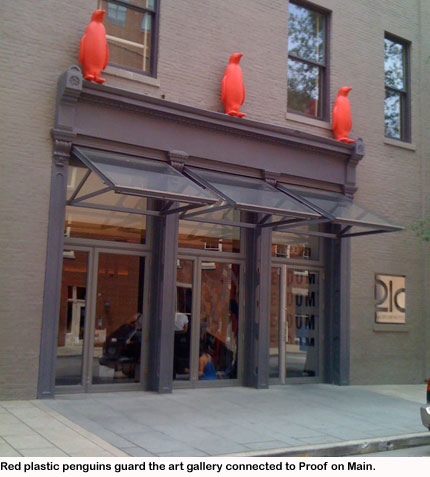
Bistro La Belle. This fine restaurant and cocktail bar in Midway, which is only a 15-minute drive from either Frankfort or Lexington, is soooo worth seeking out. Midway is a) a picturesque town of under 2,000 where a railroad runs smack down the middle of Main Street and b) a gathering place for an international clientele connected to the business of breeding and racing horses. Walt Mates, who became a fan of drinkboston a few years back while he was transitioning from bookstore owner to classic mixologist, welcomed us to his bar and mixed us real-deal Singapore Slings and Palomas before we sat down to an absolutely delicious dinner. Thanks again to Walt and owner Laura Wolfrom for your hospitality (and for recommending a nightcap at the pleasantly dive-y Dragon Pub on the Kentucky River in Frankfort, where we had shots of Buffalo Trace’s downmarket aged bourbon — Ancient Ancient Age, or “Triple-A” — with Bud chasers and listened to the karaoke contest taking place upstairs).
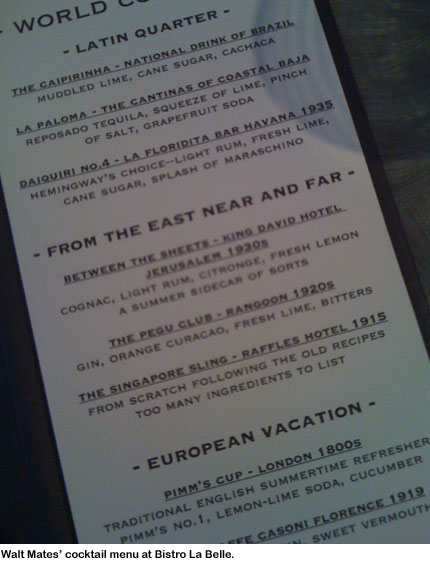
Tags: Bill Samuels Jr., Bistro La Belle, bourbon, Bourbons Bistro, Brown Hotel, Frankfort, Kentucky, Louisville, Midway, Proof on Main, Seelbach Hotel
Posted in Cocktails, Whiskey | 3 Comments »
June 27th, 2010
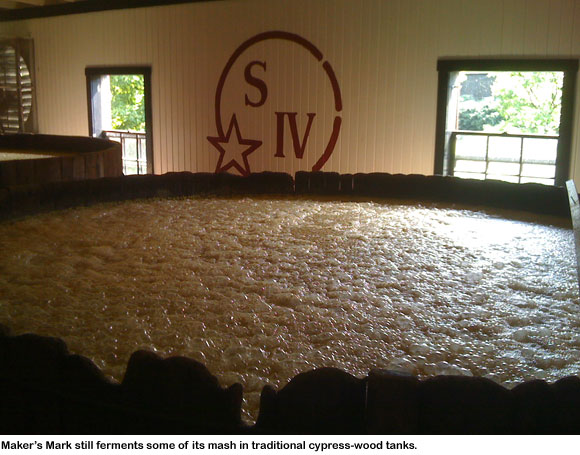
Here’s what I learned when I drank the Kentucky bourbon trail: 1. I like bourbon. 2. So do a lot of other people. The state’s 10 distilleries are well aware of this, of course. They’re priming for continued growth — not just in consumption, as more and more people around the world appreciate a fine, aged American whiskey, but also in tourism, as more and more people around the world start to view the triangle between Louisville, Frankfort and Bardstown like Napa Valley. That’s the idea, anyway.
First, some context about our most prized native spirit. Up until the turn of the millennium, bourbon, with a couple exceptions, had been in serious decline. It was an old-man drink, often with “old” right on the label. By 1997, consumption had fallen to fewer than 13 million cases, less than half bourbon’s total in 1980. But by 2009, the alignment of our aspirational taste for good food and drink with the advent of boutique bourbons had turned consumption back around to roughly 18.6 million cases and growing. That growth is driven both by the top-selling premium brands Jim Beam, Wild Turkey, Evan Williams and Maker’s Mark, and their high-end siblings like Booker’s, Eagle Rare and Van Winkle. (Jack Daniels, which is not a bourbon but a Tennessee whiskey, dwarfs all of these brands. A few years ago, it surpassed Johnny Walker Red as the world’s largest-selling single whiskey brand. But that’s another story.)

Some interesting tidbits about the bourbon world
- Everyone claims to be the oldest distillery. Don’t even try to keep track — it doesn’t matter. Distilling has been going on in Kentucky since it was settled in the 1700s, and chances are bourbon was being made on most of these sites, continuously or sporadically, for a very long time. By the way, there were hundreds of distilleries in the state before Prohibition. That fateful experiment, followed by World War II, industry consolidation and the U.S. shift in taste away from bourbon in the late 20th century, cut that number down to today’s 10.
- Everyone knows each other. Every time we left one distillery for another, we were told to “say hello to Al,” or “say hi to Jimmy for me.” And the old Kentucky distilling families are intertwined. Bill Samuels Jr. (of Maker’s Mark) and his sisters grew up playing with Beam kids, for instance, and the Beam family tree has branches that have touched many distilleries past and present. Notable among these is Heaven Hill, which has long been owned by the Shapira family but has employed three generations of Beams as master distillers.
- Most of Kentucky’s bourbon distilleries are owned by liquor conglomerates or large holding companies. That’s just the spirits business these days — don’t hold it against them.
- Bourbon may owe its life to Japan, Europe and Australia. These and a few other key countries accounted for a good chunk of bourbon’s market share during the stagnant years and have fueled its growth in the past 20 years or so.
- Here’s a handy cheat sheet on bourbon: what it is, its different flavor profiles, small-batch vs. single-barrel, etc.
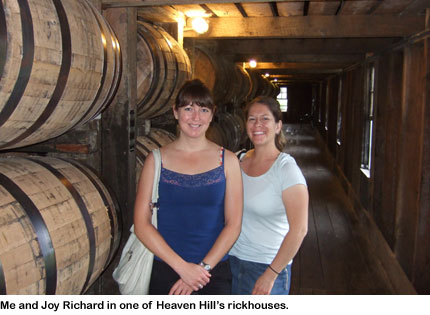
The trail
The official Kentucky Bourbon Trail was established by the Kentucky Distillers Association (KDA) in 1999. However, I refer to the unofficial bourbon trail, because not all Kentucky distilleries are part of the KDA and therefore aren’t listed on the official trail.
Joy Richard (aka Bourbon Belle of LUPEC Boston) of the Franklin Cafe, the Franklin Southie and the soon-to-open Citizen Pub, which will feature a whiskey bar, was my partner on this expedition. Like me, she enjoys asking geeky questions about bourbon by day and drinking bourbon by night. We unfortunately could not hit all of the distilleries in Kentucky. We missed Jim Beam, Woodford Reserve and the new Tom Moore distillery, along with the Oscar Getz Museum of Whiskey History in Bardstown. Hey, that gives us a few very good reasons to head back soon. Here’s a cheat sheet on the distilleries we visited, and their bourbons.
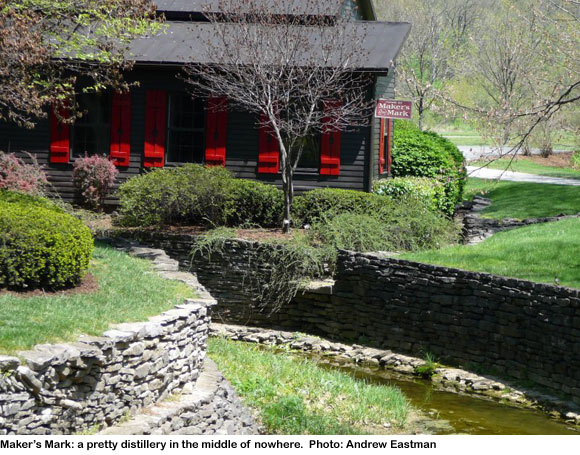
Maker’s Mark, Loretto
Owned by: Fortune Brands
Whiskies: Maker’s Mark, Maker’s 46
National Register of Historic Places
In a nutshell: The distillery’s storybook-like setting pretty much put bourbon tourism on the map, attracting over 90,000 visitors a year. Highlights: dipping my finger in various stages of sour mash fermenting in cypress-wood vessels that some Kentucky distilleries keep around for show (the bulk of fermentation happens in stainless steel now); tasting different stages of Maker’s Mark as it aged in the rickhouse; tasting the new Maker’s 46; learning that Marjorie Samuels, wife of the distillery’s founder, came up with the bourbon’s name and designed its label and red wax-sealed bottle.
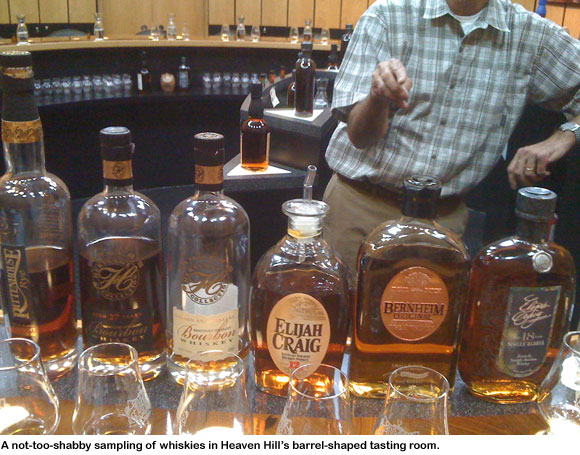
Heaven Hill, Bardstown, Louisville
Owned by: Heaven Hill Distilleries, Inc.
Whiskies include: Evan Williams, Elijah Craig, Parker’s Heritage Collection, Fighting Cock, Old Fitzgerald, Bernheim wheat whiskey, Rittenhouse rye whiskey, Pikesville rye whiskey.
In a nutshell: Heaven Hill’s huge rickhouses boast one of the largest inventories of aging whiskey in the world. The distillery upped the bourbon trail ante in 2004 when it opened its Bourbon Heritage Center in Bardstown, complete with a museum of bourbon history and barrel-shaped tasting room. Highlights: inhaling angel’s share in one of HH’s seven-story rickhouses; tasting rarities such as the 27-year-old Parker’s Heritage bourbon (an almost cognac-like exception to the rule that bourbon of such age tastes like wood chips) and 25-year-old Rittenhouse rye. Woohoo!

Four Roses, Lawrenceburg
Owned by: Kirin Brewing Co. Ltd.
National Register of Historic Places
Whiskies include: Four Roses Yellow, Small Batch, Single Barrel, Limited Edition and Mariage Collection.
In a nutshell: Very pretty (and unusual) Spanish mission-style buildings dating from 1910 house this distillery. Four Roses was one of the biggest-selling bourbons in the U.S. from the 1930s-1950s. Then its parent company, Seagrams, essentially took the brand to Japan, where it remained until the early 2000s. Now it’s making a deserved comeback. Highlights: learning about how Four Roses uses two mashbills (grain recipes) and five yeast strains to create different flavor profiles with which to blend its whiskies; tasting the deliciously dry Four Roses Single Barrel.
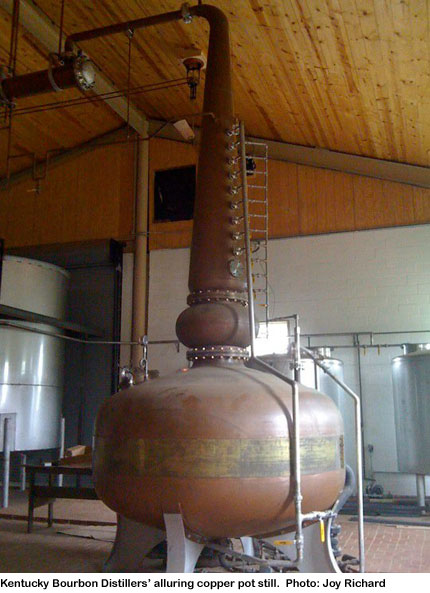
Kentucky Bourbon Distillers, Bardstown
Owned by: Kentucky Bourbon Distillers, Ltd.
Whiskies include: Black Maple Hill, Noah’s Mill, Rowan’s Creek, Willett, Johnny Drum
In a nutshell: Even Kulsveen, a Norwegian who married into the Willett family that established a distillery on this site after Prohibition, runs this boutique operation with his son, daughter and son-in-law. Finally nearing completion on a many-years-long rebuilding of the distillery, Kulsveen has built his reputation on blending great craft bourbons from casks procured from other distilleries. Highlights: getting an impromptu tour by the family behind this mysterious operation, including Kulsveen himself, who apparently is famous for his reclusivity.
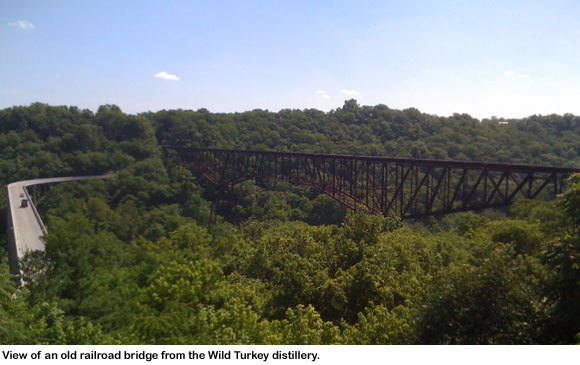
Wild Turkey, Lawrenceburg
Owned by: Gruppo Campari
Whiskies include: Wild Turkey 80 and 101, Rare Breed, Russell’s Reserve, Kentucky Spirit
In a nutshell: Mostly built in the 1930s, this romantically industrial distillery looks like something out of a promotional film for the WPA. A new distillery under construction will double Wild Turkey’s capacity. Highlights: seeing a load of corn spill out of the underbelly of a truck into an underground holding vessel before being conveyed up into tall silos; climbing to the top of the building that houses the tall column still and tasting the white dog (unaged whiskey) coming out of it before stepping onto a deck overlooking a cool, old railroad bridge.
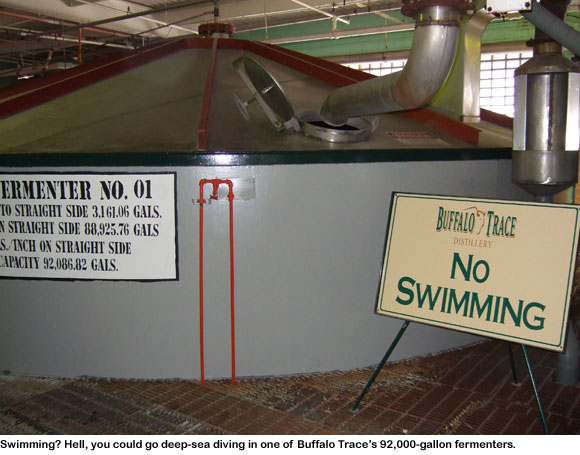
Buffalo Trace, Frankfort
Owned by: Sazerac Company, Inc.
Whiskies include: Buffalo Trace, Blanton’s, Sazerac, Eagle Rare, Van Winkle, W.L. Weller, Ancient Age
National Register of Historic Places
In a nutshell: Located on what was once an ancient buffalo trace, or crossing, on the banks of the Kentucky River, Buffalo Trace has several brick buildings dating back to the late 1800s. It is large but charming, and its visitors center features lots of great, old photos of bourbon distilling. Highlights: peering into the frighteningly deep 92,000-gallon, 1930s-era fermentation tanks; inhaling angel’s share in the distillery’s historic 1800s-era Warehouse C; witnessing the bottling of Blanton’s single-barrel destined for Australia.

Tags: bourbon, distilleries, Kentucky
Posted in Whiskey | 9 Comments »
June 19th, 2010

When Maker’s Mark president Bill Samuels Jr. and his master distiller, Kevin Smith, decided to make their company’s first new bourbon in over 50 years, they could have gone the well-traveled route: an extra-aged, high-proof whiskey with “reserve” in the name (and a price tag well over $50). But their whole philosophy goes against the whopping spice, caramel, smoke and tannic flavors that can come from extended time in charred oak barrels. They’re all about toasty, mellow, vanilla — a flavor profile they get by blending whiskey from barrels that rotate through three-story rickhouses (barrel-aging warehouses) for a “mere” six to eight years, compared to 12-20+ for some boutique bourbons. So, they decided to simply take their regular Maker’s Mark bourbon and amp it up it somehow. But how? Enter the wood chef.
I admit I laughed when I heard that term, too. (Disclosure: Maker’s Mark flew me down to Kentucky to check out the distillery.) But I realized it wasn’t a stretch when I talked to the chef himself, Brad Boswell of the Independent Stave Company. Boswell’s family has been making oak barrels for aging spirits and wine for 98 years. And lately, they have brought a healthy dose of science to their medieval craft. They begin with a thorough understanding of the chemical composition of different species of oak, and of the appropriate length of seasoning (aging oak staves in the open air) for the intended beverage. Then they cook the staves or finished barrels according to a library of recipes that “pinpoint layers of flavor” between toasted and charred, says Boswell. Basically, he can make you a barrel that imparts to its contents the exact characteristics you’re looking for.

In Maker’s Mark’s case, those characteristics were “sweet toasty oak, not smoky. Forward on the palate. Long finish. No sour or bitter aftertaste. A little spicy,” say my notes from a conversation with Smith. But the distiller knew that that particular combo of spicy notes and long finish typically go hand in hand with at least a bit of smokiness, sourness and bitterness. “We were asking for the impossible,” says Smith. In fact, they were asking for something that couldn’t be achieved with any sort of aging regime in the charred barrels that are standard to the bourbon industry. (The wood on the inside of the barrel is literally blackened with fire.)
It took 125 experiments — many of which “sucked,” says Smith — to hit upon the right wood recipe, one that was entirely new in bourbon making. It begins with French, rather than the standard American, oak staves. Those staves are seasoned for a long 18 months, which lowers the wood’s tannins and intensifies its vanillins. Boswell then tried a new cooking technique: he seared the staves on both sides, like a steak, to just short of charred. Boswell catalogued this recipe as Profile No. 46.
Smith arrayed 10 of the staves in an empty Maker’s barrel, then poured the fully matured bourbon back in to rest for about nine weeks. The combination of the seasoned French oak and Boswell’s searing method gave just the sweet toastiness and spicy notes — think cinnamon instead of rye bread — that Maker’s wanted. Samuels and Smith had their new product, and they decided to name it Maker’s 46, after Boswell’s special wood recipe.
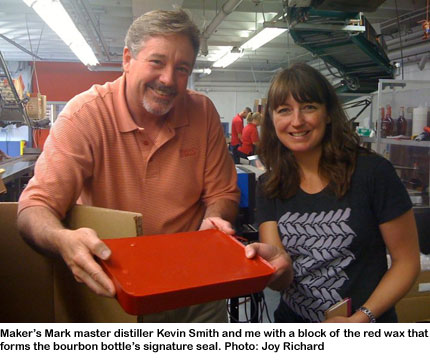
This may all sound pretty esoteric, but the result is a bourbon quite different from Maker’s Mark. The 46 has a dry spiciness, a rich texture and a higher proof (94 compared to 90 for the flagship) that are sure to appeal to the bourbon, and even rye, adventurer, without alienating the devoted Maker’s Mark drinker. And it’s reasonably priced at about $10 more than traditional Maker’s, which is usually $23 to $25. Maker’s 46 will be available in Boston sometime next month.
The 70-year-old Samuels, a seventh-generation distiller who is nearing retirement, seems pleased by the new whiskey. He admits that it arose partly out of market demand for something new and exciting from Maker’s, which largely created the premium bourbon category that is now exploding. But he also wanted to be remembered for something other than faithfully reproducing his father’s bourbon recipe from the 1950s. Now his nightmares of a tombstone that says, simply, “He didn’t screw it up,” are over.
Coming up: my tour of the Kentucky bourbon trail.
Tags: Bill Samuels Jr., bourbon, Brad Boswell, Kentucky, Kevin Smith, Maker's 46, Maker's Mark
Posted in Booze in the news, Whiskey | 8 Comments »

 The Brown Hotel Bar. This is in the opulent, marble-enclosed lobby of Louisville’s other grand, old hotel, built in 1923. The comparatively tiny bar nonetheless carries a wide selection of bourbons. I sipped on a Jefferson’s Reserve (a very small-batch whiskey launched by writer and bourbon historian Chet Zoeller) and struck up a conversation with the bourbon drinker sitting next to me. He turned out to be an Australian linguist and alumnus of my daytime employer (MIT) who teaches theater in prisons. This is why I go to bars.
The Brown Hotel Bar. This is in the opulent, marble-enclosed lobby of Louisville’s other grand, old hotel, built in 1923. The comparatively tiny bar nonetheless carries a wide selection of bourbons. I sipped on a Jefferson’s Reserve (a very small-batch whiskey launched by writer and bourbon historian Chet Zoeller) and struck up a conversation with the bourbon drinker sitting next to me. He turned out to be an Australian linguist and alumnus of my daytime employer (MIT) who teaches theater in prisons. This is why I go to bars.















